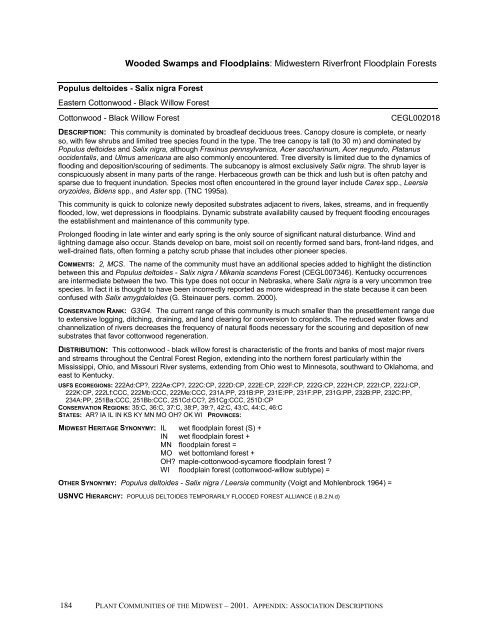Ohio subset of Plant Communities of the Midwest ... - NatureServe
Ohio subset of Plant Communities of the Midwest ... - NatureServe
Ohio subset of Plant Communities of the Midwest ... - NatureServe
You also want an ePaper? Increase the reach of your titles
YUMPU automatically turns print PDFs into web optimized ePapers that Google loves.
Wooded Swamps and Floodplains: <strong>Midwest</strong>ern Riverfront Floodplain Forests<br />
Populus deltoides - Salix nigra Forest<br />
Eastern Cottonwood - Black Willow Forest<br />
Cottonwood - Black Willow Forest<br />
CEGL002018<br />
DESCRIPTION: This community is dominated by broadleaf deciduous trees. Canopy closure is complete, or nearly<br />
so, with few shrubs and limited tree species found in <strong>the</strong> type. The tree canopy is tall (to 30 m) and dominated by<br />
Populus deltoides and Salix nigra, although Fraxinus pennsylvanica, Acer saccharinum, Acer negundo, Platanus<br />
occidentalis, and Ulmus americana are also commonly encountered. Tree diversity is limited due to <strong>the</strong> dynamics <strong>of</strong><br />
flooding and deposition/scouring <strong>of</strong> sediments. The subcanopy is almost exclusively Salix nigra. The shrub layer is<br />
conspicuously absent in many parts <strong>of</strong> <strong>the</strong> range. Herbaceous growth can be thick and lush but is <strong>of</strong>ten patchy and<br />
sparse due to frequent inundation. Species most <strong>of</strong>ten encountered in <strong>the</strong> ground layer include Carex spp., Leersia<br />
oryzoides, Bidens spp., and Aster spp. (TNC 1995a).<br />
This community is quick to colonize newly deposited substrates adjacent to rivers, lakes, streams, and in frequently<br />
flooded, low, wet depressions in floodplains. Dynamic substrate availability caused by frequent flooding encourages<br />
<strong>the</strong> establishment and maintenance <strong>of</strong> this community type.<br />
Prolonged flooding in late winter and early spring is <strong>the</strong> only source <strong>of</strong> significant natural disturbance. Wind and<br />
lightning damage also occur. Stands develop on bare, moist soil on recently formed sand bars, front-land ridges, and<br />
well-drained flats, <strong>of</strong>ten forming a patchy scrub phase that includes o<strong>the</strong>r pioneer species.<br />
COMMENTS: 2, MCS. The name <strong>of</strong> <strong>the</strong> community must have an additional species added to highlight <strong>the</strong> distinction<br />
between this and Populus deltoides - Salix nigra / Mikania scandens Forest (CEGL007346). Kentucky occurrences<br />
are intermediate between <strong>the</strong> two. This type does not occur in Nebraska, where Salix nigra is a very uncommon tree<br />
species. In fact it is thought to have been incorrectly reported as more widespread in <strong>the</strong> state because it can been<br />
confused with Salix amygdaloides (G. Steinauer pers. comm. 2000).<br />
CONSERVATION RANK: G3G4. The current range <strong>of</strong> this community is much smaller than <strong>the</strong> presettlement range due<br />
to extensive logging, ditching, draining, and land clearing for conversion to croplands. The reduced water flows and<br />
channelization <strong>of</strong> rivers decreases <strong>the</strong> frequency <strong>of</strong> natural floods necessary for <strong>the</strong> scouring and deposition <strong>of</strong> new<br />
substrates that favor cottonwood regeneration.<br />
DISTRIBUTION: This cottonwood - black willow forest is characteristic <strong>of</strong> <strong>the</strong> fronts and banks <strong>of</strong> most major rivers<br />
and streams throughout <strong>the</strong> Central Forest Region, extending into <strong>the</strong> nor<strong>the</strong>rn forest particularly within <strong>the</strong><br />
Mississippi, <strong>Ohio</strong>, and Missouri River systems, extending from <strong>Ohio</strong> west to Minnesota, southward to Oklahoma, and<br />
east to Kentucky.<br />
USFS ECOREGIONS: 222Ad:CP, 222Ae:CP, 222C:CP, 222D:CP, 222E:CP, 222F:CP, 222G:CP, 222H:CP, 222I:CP, 222J:CP,<br />
222K:CP, 222Lf:CCC, 222Mb:CCC, 222Me:CCC, 231A:PP, 231B:PP, 231E:PP, 231F:PP, 231G:PP, 232B:PP, 232C:PP,<br />
234A:PP, 251Ba:CCC, 251Bb:CCC, 251Cd:CC, 251Cg:CCC, 251D:CP<br />
CONSERVATION REGIONS: 35:C, 36:C, 37:C, 38:P, 39:, 42:C, 43:C, 44:C, 46:C<br />
STATES: AR IA IL IN KS KY MN MO OH OK WI PROVINCES:<br />
MIDWEST HERITAGE SYNONYMY: IL wet floodplain forest (S) +<br />
IN wet floodplain forest +<br />
MN floodplain forest =<br />
MO wet bottomland forest +<br />
OH maple-cottonwood-sycamore floodplain forest <br />
WI floodplain forest (cottonwood-willow subtype) =<br />
OTHER SYNONYMY: Populus deltoides - Salix nigra / Leersia community (Voigt and Mohlenbrock 1964) =<br />
USNVC HIERARCHY: POPULUS DELTOIDES TEMPORARILY FLOODED FOREST ALLIANCE (I.B.2.N.d)<br />
PLANT COMMUNITIES OF THE MIDWEST – 2001. APPENDIX: ASSOCIATION DESCRIPTIONS<br />
184
















